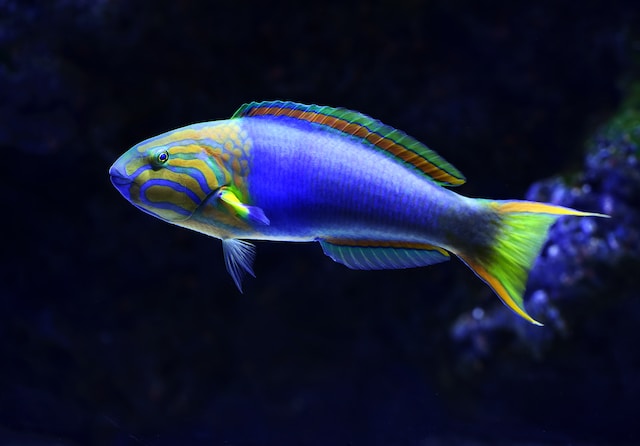Cold-blooded creatures rely on their external surroundings for temperature regulation, whereas warm-blooded mammals can actively regulate their own body temperatures through metabolic processes regardless of their external environment.
What is Cold blooded?
(Photo by David Clode on Unsplash )

“Cold-blooded” is a term used to describe animals whose body temperature is regulated by the environment rather than by internal mechanisms like warm-blooded animals. Cold-blooded animals are also referred to as “ectothermic” animals, which means their body temperature is determined by the temperature of their surroundings. Examples of cold-blooded animals include reptiles, amphibians, fish, and invertebrates like insects and arachnids. These animals are often more active in warm weather and tend to slow down or become dormant in cold weather.
What is warm blooded?
(Photo by Lloyd Henneman on Unsplash )

“Warm-blooded” is a term used to describe animals whose body temperature is regulated internally by their metabolism, rather than by the environment. These animals are also referred to as “endothermic” animals, which means they generate their own body heat through internal processes, such as shivering or sweating. Examples of warm-blooded animals include mammals and birds. These animals can maintain a relatively constant body temperature, regardless of changes in the external environment. This allows them to be active in a wide range of temperatures and environments, making them highly adaptable to different climates and habitats.
Cold blooded Vs. Warm blooded – Key differences
Body temperature: Cold-blooded animals, also known as ectothermic animals, have a body temperature that varies with the temperature of their environment. In contrast, warm-blooded animals, also known as endothermic animals, can regulate their body temperature internally and maintain a constant temperature regardless of the external environment.
Metabolic rate: Cold-blooded animals have a lower metabolic rate than warm-blooded animals. This means they require less food to survive and can go for longer periods of time without eating.
Activity level: Cold-blooded animals are often less active than warm-blooded animals, especially in cooler temperatures. Warm-blooded animals, on the other hand, are able to remain active in a wide range of temperatures and can maintain a consistent level of activity throughout the day.
Adaptability: Warm-blooded animals are generally more adaptable to different environments than cold-blooded animals. This is because they can regulate their body temperature internally and maintain a consistent level of activity, regardless of the temperature outside.
Habitat: Cold-blooded animals are more commonly found in aquatic environments or in warm, tropical climates. Warm-blooded animals, on the other hand, can be found in a wide range of habitats, including arctic regions and deserts.
The key difference between cold-blooded and warm-blooded animals is how they regulate their body temperature and metabolic rate. Cold-blooded animals are more dependent on their environment to regulate their body temperature, while warm-blooded animals have the ability to regulate their body temperature internally.
What are examples of cold blooded animals?
Reptiles: Snakes, lizards, turtles, and crocodilians are all ectothermic animals. They rely on the sun or external heat sources to warm their bodies and regulate their body temperature.
Amphibians: Frogs, toads, salamanders, and newts are also ectothermic animals. They have permeable skin that allows them to absorb moisture and regulate their body temperature through evaporative cooling.
Fish: Most fish species are ectothermic animals, with body temperature that is determined by the temperature of the water around them.
Invertebrates: Many invertebrates like insects, spiders, and mollusks are ectothermic animals. They rely on external sources of heat to regulate their body temperature and maintain their metabolic processes.
These animals are typically found in a variety of environments, including deserts, tropical rainforests, and aquatic habitats.
What are examples of warm blooded animals?
Mammals: All mammals are endothermic animals, meaning they generate their own body heat through internal processes. Examples of mammals include dogs, cats, horses, cows, monkeys, humans, and many more.
Birds: All birds are also endothermic animals, and they are able to regulate their body temperature through various mechanisms, including shivering, panting, and fluffing their feathers.
These animals are typically found in a wide range of environments, including cold arctic regions, hot deserts, and tropical rainforests. They are able to maintain a relatively constant body temperature regardless of the external environment, allowing them to be active and thrive in a variety of habitats.
The advantages and disadvantages of being warm blooded
Advantages:
- More active: Warm-blooded animals are able to maintain a consistent level of activity and stay active in a wide range of temperatures. They are able to move quickly and efficiently, which can be an advantage in hunting, escaping predators, or finding food.
- Better at enduring cold: Because warm-blooded animals can regulate their body temperature internally, they are better adapted to survive in cold environments than cold-blooded animals.
- Better able to adapt: Endothermic animals are generally better adapted to changes in their environment than ectothermic animals, which can be beneficial in unpredictable or changing environments.
Disadvantages:
- Need for food: Endothermic animals require a lot of energy to maintain their body temperature, which means they need to eat more food than ectothermic animals of a similar size. This can make it more difficult for them to find enough food to survive in certain environments.
- Overheating: If warm-blooded animals are exposed to high temperatures for too long, they can overheat and become exhausted. This can be a disadvantage in hot environments where it’s difficult to find a cool place to rest.
- More complex physiology: Maintaining a constant body temperature requires a more complex physiology than simply adapting to the external environment, which can be more energy-intensive and potentially more prone to failure or disease.
The advantages and disadvantages of being warm-blooded depend on the animal’s environment and specific adaptations. In general, warm-blooded animals are better suited to survive in a wider range of temperatures and environments than cold-blooded animals, but they also require more energy to maintain their body temperature.
The advantages and disadvantages of being cold blooded
Advantages:
- Energy-efficient: Cold-blooded animals don’t need to consume as much food as warm-blooded animals because they don’t need to generate internal heat to maintain their body temperature. This can be an advantage in environments where food is scarce.
- Better at enduring heat: Ectothermic animals can tolerate higher temperatures than endothermic animals because they don’t generate as much internal heat. This can be an advantage in hot environments where it’s difficult to find a cool place to rest.
Lower risk of overheating: Because they don’t generate as much internal heat, ectothermic animals are less likely to overheat and become exhausted than warm-blooded animals.
Disadvantages:
- Slower metabolism: Cold-blooded animals have a slower metabolism than warm-blooded animals, which can make it more difficult for them to find food and escape predators.
- Limited range of activity: Ectothermic animals are limited in their activity range by the temperature of their environment. If the environment is too cold, they may be unable to move, feed or reproduce.
- Less adaptable: Because they are more dependent on their environment for heat, cold-blooded animals are less adaptable to changes in temperature and climate than warm-blooded animals.
The advantages and disadvantages of being cold-blooded depend on the animal’s environment and specific adaptations. In general, cold-blooded animals are better suited to survive in environments where energy is scarce and temperatures are stable, but they may be less adaptable to changes in their environment than warm-blooded animals.
Featured Image By – Ahmed Zayan on Unsplash








